How to Legally Fly a Drone for Commercial Use
Drones can be a lot of fun to fly, which is one of the primary reasons why consumer-grade drones have become so popular. However, some drone pilots take their drones a bit more seriously. For commercial drone pilots, their drone flight skills have become an essential tool for their livelihood.
However, flying a drone commercially isn’t as simple as buying a drone and accepting a job. Since drones have become extremely popular, the FAA has stepped to regulate commercial drone operations. What does a drone pilot need to do to make sure that they are flying legally?
1. Register your drone
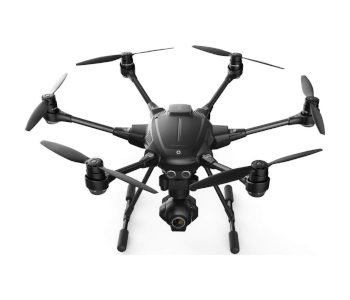
Whether you are flying your drone commercially or recreationally, you need to register it with the FAA if it weighs between 0.55 and 55 lbs. This broad weight range includes practically all drones designed for outdoor flight, including the most popular models from DJI, Yuneec, and Parrot. Chances are, unless you’re just flying a mini-drone, you will need to go through the drone registration process.
Fortunately, the FAA has made it very easy to register your drone. All you need to do is to sign up for an account in the FAA’s DroneZone portal. To do this, you only need to be 13 years of age and have a valid email address. Upon signing up, a registration link will be sent to your email address which will prompt you to input your mailing address and pay the $5 registration fee.
After paying the fee and providing the information, you should receive a unique drone registration number. According to the most recent rules released by the FAA, your drone needs to be marked with this registration number at a spot in the drone’s external surface where it is immediately visible upon inspection. This recent change was made to protect law enforcers and first responders from the dangers of having to open up a ‘renegade’ drone which might contain small explosives.
If you have multiple drones, the good news is that you won’t need to go through the drone registration process more than once. All you have to do is to label all of your drones with your registration number. This requirement to label the drones you own was made to create a mechanism of accountability and responsible drone flight among drone pilots.
2. Get a Part 107 license
The FAA created the Part 107 rules for commercial drone flight around three years ago. Since then, hundreds of thousands have drone pilots have gained their remote plot certificate. This ‘drone license’ is one of the most important requirements of being a commercial drone pilot. Without the drone license, you cannot fly a drone legally for commercial purposes.
Getting the drone license takes some time and requires a considerable amount of effort. Without a doubt, the biggest hurdle in getting the license is the Part 107 knowledge test. Consisting of 60 multiple choice questions, the knowledge test covers topics such as airspace classifications, meteorology, weather reports, drone loading and performance, and relevant Part 107 restrictions. As these topics aren’t exactly general knowledge, you will need some time to prepare for the test.
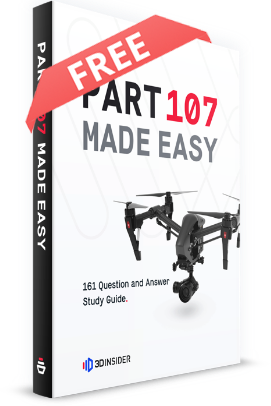
PART 107 Made Easy
- 161 Question and Answer Study Guide
- 105 pages of illustrated content
- Covers all parts of the Part 107 test
- $97 of value for free
Screening qualifications
Before you even think about taking the Part 107 knowledge test, make sure that you can comply with the eligibility requirements. They are pretty simple; you need to be at least 16 years of age, be in a fit physical and mental state to fly a drone, and be able to read, write, speak, and understand English.
Sign up for the knowledge test
If you believe that you’re eligible to take the test, then you can proceed to sign up with any of the almost 700 FAA-authorized testing centers located all over the country. With so many testing centers, you are sure to find one that’s near you. Before you can take the test, you will need to pay the $150 testing fee and present a valid government-issued ID.
Pass the knowledge test
Now that you’ve signed up for the test, you just need to pass it. To pass the test, you will need to answer at least 70% of the 60 questions correctly. The test isn’t exceptionally, but it isn’t exactly a walk in the park, either. Most people who have taken the knowledge test recommend spending at least 15 hours of focused studying to prepare for the test. Fortunately, there are a ton of reading materials and learning resources available online for the Part 107 knowledge test. You can choose to sign up for a paid training course or to use as much of the free resources that you can find online.
You will be given two hours to complete the knowledge test. You will be provided a copy of the Airman Knowledge Testing Supplement book during the test, which you will use to look for relevant section charts and map legends. To save time during the test, it is worth the effort to familiarize yourself with this book as part of your preparations.
An important piece of advice is to take you time. The two-hour allowance is more than enough to finish the test and to even give the whole test a do-over. Since you don’t need to worry about the time, all you need to be concerned with is coming up with the best answer to each question.
After completing the test, you should be able to check the results in the FAA website within 48 to 72 hours. If you have passed, you will be given a code for the successful test results, which you’ll need for the succeeding steps in the process.
Pass TSA screening
Once you have the test results, you can sign up for the remote pilot certificate through the FAA’s Integrated Airman Certification and Rating (IACRA) system. After signing up for an account, you only need to provide the code for the test results so you can proceed to the application process.
Before you can officially receive the license, you will have to go through a background screening check by the TSA. This step does not require your participation – all you can do is wait while the TSA does their thing. Nobody knows exactly what the TSA looks for during the screening, or how long it will take them to finish. We have heard of people receiving their license in less than two weeks, while others had to wait up to two months. It probably depends on the FAA or TSA’s backlog and the number of drone pilots applying for the license.
Once the TSA has finished their background screening, you should receive a temporary certificate by email. This temporary certificate is only valid for 120 days while the permanent certificate makes its way to you by regular mail. It should not take more than two months for you to receive your permanent certificate.
3. Follow Part 107 rules
Getting a Part 107 license gives you the privilege of using your drone for commercial purposes legally. However, the license also comes with a few responsibilities. If you’re flying under a Part 107 license, then you will also need to comply with all the restrictions enforced by the FAA for commercial drone flight. The most important of these rules include:
- Flying your drone only during daytime or during twilight (30 minutes after sunset or 30 minutes before sunrise) only if your aircraft is equipped with appropriate anti-collision lighting.
- Flying your drone at a maximum ground speed of 100 mph and up to a maximum altitude of 400 feet. The 400-foot altitude limit may be waived when flying within 400 feet of a structure.
- Not flying your drone outside of visual line-of-sight (VLOS) of the pilot or a second observer.
- Flying only one drone at a time. Neither the remote operator nor a second observer may be responsible for multiple drones at the same time.
- Securing air traffic control (ATC) permission when flying in Class B, C, D, or E airspace. Only flight in Class G is allowed without coordination with ATC.
- Not flying a drone from a moving vehicle or aircraft. This rule can be waived if flying over a sparsely populated area.
- Not flying a drone when you are under the influence of alcohol or drugs, or any under condition that may hamper your piloting capabilities.
- Conduct a pre-flight safety inspection to make sure that the drone is in a condition for safe operation.
- Reporting any drone-related accident within ten days if it has resulted in serious injury to any person or at least $500 of property damage.
Take note that you may be required to present your remote pilot certificate by an FAA representative of local law enforcer, so it’s best to keep it with you at all times. The FAA also has the authority to submit your drone for inspection, as well as any other flight-related documents or records.
The FAA has a provision allowing for some of these restrictions to be waiver subject to their approval. For instance, the FAA has allowed for more than 1,000 cases of drone flight at night for various commercial applications. It’s a long process – approval can take up to 90 days, and the pilot-in-command needs to provide a very detailed account of how the activity will proceed, the potential risks, and how these risks can be mitigated.
The Part 107 drone license is only valid for two years. Once the license has expired, the drone pilot must pass a recurrent knowledge test to renew the license. The recurrent knowledge test is structured much like the original knowledge test – 60 items, multiple choice, two-hour time limit. However, the subject scope of the recurrent knowledge test is a little smaller. You will need to pay another $150 to take the recurrent knowledge test.
4. Laws for traveling with your drone
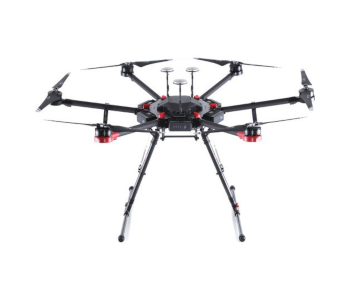
One thing that many commercial drone pilots typically fail to educate themselves on is the set of laws for traveling with your drone. Commercial drone gigs may take you to a lot of places within the country or abroad. Should such a situation come up, certain measures can be made to ensure a smooth experience when taking a plane.
Check airline rules
Drones have become so common nowadays that many airlines have come up with clear rules on how they will handle passenger luggage containing drones. Most airlines permit drones as carry-on baggage, although there a few exceptions. For instance, Emirates only allows drones as checked-in baggage because of security reasons. If you’re flying with a drone, take the time to ask your airline a few days ahead of your flight about their policies on drones and their accessories.
Ask about the rules on batteries
If there’s a component in drones that you need to make extra precautions for, it’s the batteries. According to TSA rules, all lithium-ion batteries can be included in carry-on baggage as long as they are rated below 100 Watt-hours. There is no limit to how many of these batteries you can bring onboard. This limit should cover most consumer devices including cellphones, tablets, and laptops.
It’s also possible to bring bigger batteries up to 160 Watt-hours, but only two o them can be carried on. For this reason, many drone manufacturers offer battery options that fall just below the 100 Watt-hour limit so you won’t need to worry about how many batteries you can bring in your trip.
Despite the TSA rules, it is still best to ask your airline about their rules on batteries. Different airlines can have different rules. For instance, American Airlines only allows up to four spare batteries in the carry-on luggage, even if these batteries are rated below 100 Watt-hours. Most airlines outright prohibit bringing along batteries rated higher than 160 Watt-hours.
If you are flying to another country, then there is another layer of due diligence you’ll need to do, as your destination country might have different laws on traveling with drones and batteries. You would not want to end up bringing along more batteries than you can take home.
Prepare for TSA inspection
Drones can look particularly interesting when they pass through X-ray machines, so don’t be surprised if you’re pulled aside by the TSA for a closer look. With a little bit of preparation, this does not have to be such a stressful situation.
To make the inspection process easier both for you and the TSA agent, we strongly recommend packing your drone and their batteries separately. This saves you from the hassle of having to open all your bags and show them your personal items so that you can retrieve the items they want to see.
5. Possible penalties
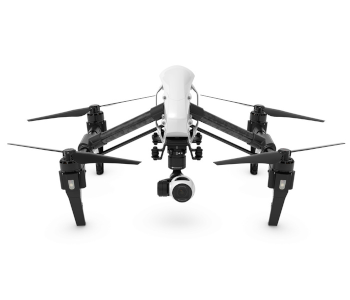
As with any law, violating the Part 107 rules will carry penalties. These can involve confiscation of your drone, payment of a fine, or possible jail time.
Flying a drone commercially without the appropriate license is subject to a penalty amounting to $32,666 for each incident. This fine will be charged per day of illegal operations, although the FAA will send a warning letter initially. Further violations of this nature can result in criminal sanctions, which can involve a fine of up to $250,000 and jail time of up to three years.
For Part 107-licensed pilots, any violation of flight rules and restrictions are subject to the same set of fines or penalties. A licensed drone pilot may be fined up to $30,000 per violation, although this amount is subject to change depending on the gravity of the violation. Unauthorized drone flight in restricted airspace such as around airports or critical infrastructure is among the most serious violations that a drone pilot can do.
Although not expressly stated, the FAA also has the authority to confiscate your drone or to revoke your drone license should you be found to be violating any of the Part 107 rules.
Here’s the thing about FAA’s enforcement of these penalties: so far, they have been pretty lenient. As of March 2019, there has been no record of criminal sanctions regarding drone flight, and rarely have civil sanctions been imposed. There have been several accounts of drone pilots receiving warning letters from the FAA, but that’s about as far as the FAA seems to be willing to go most of the time.
Is this a good thing? We can’t really say. What we can say for sure is that the lack of enforcement undermines the FAA’s authority on regulating commercial drone flight activities. It has also left many licensed drone pilots feeling that the benefits that are supposed to come with a Part 107 license have become invalidated.
Final thoughts
Commercial drone use has become a huge thing for several years now, and the demand for commercial drone services does not seem like it would be drying up soon. We have often said that the best time to start a drone-based business is right now, considering that the market is still growing and drone flight is still a rare and specialized skill.
However, starting a drone business isn’t just about having a high-end drone and being a good drone pilot. As with any other field, there are several laws that have been put in place to regulate the industry. From FAA’s perspective, the Part 107 rules create a standard for drone flight that keeps the airspace safe, avoiding aircraft-related accidents that can result in massive property damage and injury to people.
Complying with Part 107 rules all starts with getting a drone license. It does not end there, though. Licensed drone pilots are expected to bear the responsibility of following all the flight restrictions, reporting, and documentation required by the FAA. The Part 107 rules are reasonable for the most part, although they have received their fair share of criticism.
As drone technology evolves and the FAA learns lessons from the implementation of Part 107, we can expect these drone flight laws to similarly evolve soon. We have already seen evidence of this with the FAA’s proposed changes that will relax the restriction on drone flight during night and over people. This shows how the FAA has not neglected the mandate to promote commercial drone flight even while they regulate drone flight practices. It will be a long and slow process before we get the perfect legislation on drones, but we’re more than willing to come along with the ride.

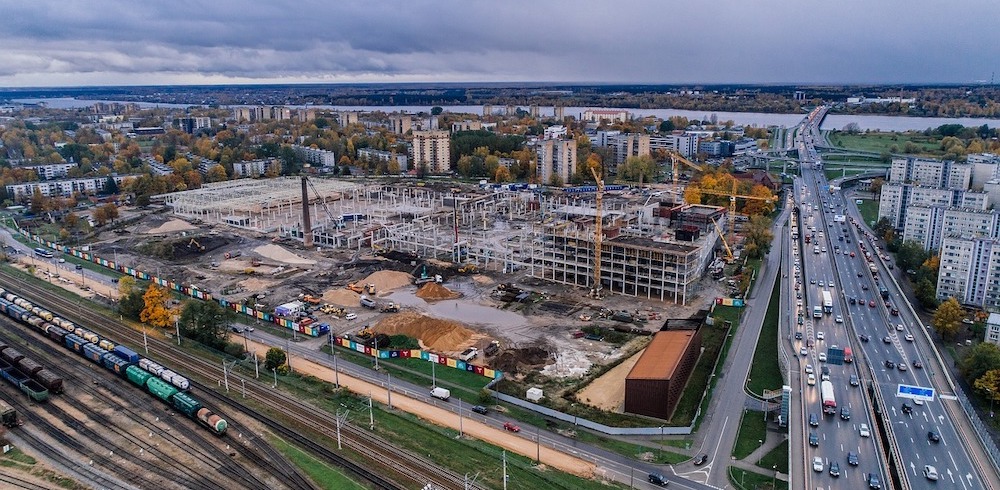

Clear and helpful advice, though there are a few typos.